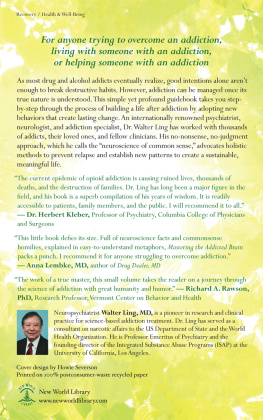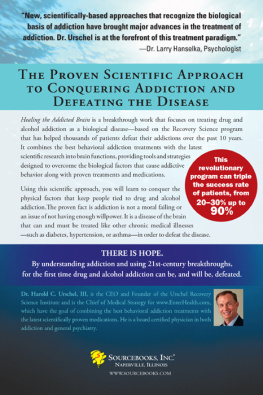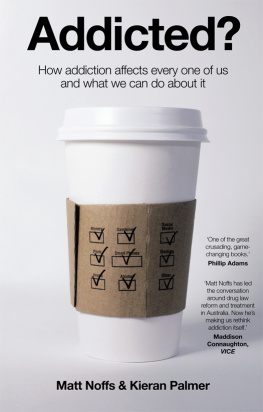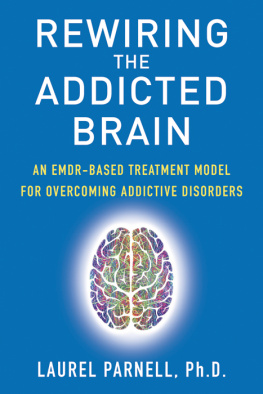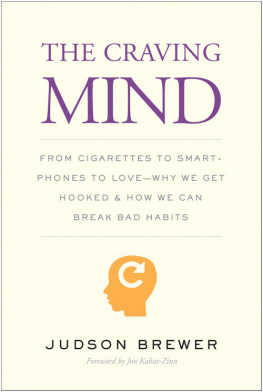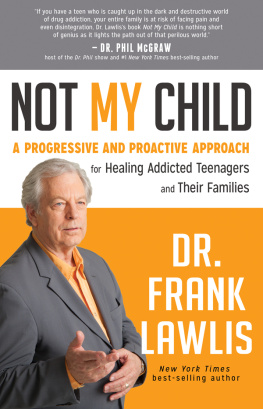The Craving Mind

The information and suggestions contained in this book are not intended to replace the services of your physician or caregiver. Because each person and each medical situation is unique, you should consult your own physician to get answers to your personal questions, to evaluate any symptoms you may have, or to receive suggestions for appropriate medications.
The author has attempted to make this book as accurate and up to date as possible, but it may nevertheless contain errors, omissions, or material that is out of date at the time you read it. Neither the author nor the publisher has any legal responsibility or liability for errors, omissions, out-of-date material, or the readers application of the medical information or advice contained in this book.
Published with assistance from the Louis Stern Memorial Fund.
Copyright 2017 by Judson Brewer. Foreword copyright by Yale University. All rights reserved. This book may not be reproduced, in whole or in part, including illustrations, in any form (beyond that copying permitted by Sections 107 and 108 of the U.S. Copyright Law and except by reviewers for the public press), without written permission from the publishers.
Yale University Press books may be purchased in quantity for educational, business, or promotional use. For information, please e-mail (U.K. office).
Printed in the United States of America.
ISBN 978-0-300-22324-8 (hardcover : alk. paper)
Library of Congress Control Number: 2016953453
A catalogue record for this book is available from the British Library.
This paper meets the requirements of ANSI/NISO Z39.481992
(Permanence of Paper).
10 9 8 7 6 5 4 3 2 1
T. S. Eliot, Burnt Norton and Little Gidding from Four Quartets. In the United States: excerpts from Burnt Norton and Little Gidding from Four Quartets by T. S. Eliot. Copyright 1936 by Houghton Mifflin Harcourt Publishing Company; Copyright renewed 1964 by T. S. Eliot. Copyright 1942 by T. S. Eliot; Copyright renewed 1970 by Esme Valerie Eliot. Reprinted by permission of Houghton Mifflin Harcourt Publishing Company. All rights reserved. In the UK and the rest of the world: published by Faber and Faber Ltd., reprinted with permission.
For all those who suffer
Contents
FOREWORD
The Craving Mind
Jon Kabat-Zinn
It is an incontrovertible fact, although it usually goes unrecognized and unappreciated, that right inside each one of our heads, underneath the encompassing vault of the cranium and weighing in at around three pounds (approximately two percent of the bodys weight), is found the most complex organization of matter in the known-by-us universe, namely the human brain. That makes us rather remarkable in terms of what we are capable of. The miracle of being human can be readily seen everywhere once you train your eye and your heart to look. It transcends and embraces all the pain and suffering that comes with the human condition, and that we so often cause ourselves and one another by ignoring who and what we really are. It is so easy to fall into ruts, bad habits, even depression, thirsting for what we feel we need to complete ourselves, what we might need to feel at home in our own skin, truly at peace in our life, even if just for a brief moment, or an hour or a day. All the while, ironically, we are missing the fact that we are actually conspiring to make ourselves slaves to an illusion, to the compulsive longing to complete ourselves when, in fact, we are already complete, already whole. But somehow, we momentarily forget this, or never remember it, or perhaps we feel so wounded that we cannot even entertain the possibility of our own essential completeness without a lot of support, and a method, a path to reclaim that wholeness (the root meaning of the words health and healing) and our beauty. This book provides just such a path, well demarcated and expertly guided by the author. You are now at the trailhead, a perfect place to begin the adventure of reclaiming the full dimensionality of your being and learning to embody your wholeness in the face of the undermining addictiveness of the craving mind.
Until quite recently, the extent of the brains complex structures, networks, and functions, its uncanny plasticity, and its versatility as a multidimensional self-organizing learning matrixa result of billions of years of evolution that is continuing to evolve surprisingly rapidly both biologically and culturally in our timewas not fully appreciated even by scientists. Now, given recent advances in neuroscience and technology, we stand in awe of the brains architecture and its seemingly boundless repertoire of capacities and functions, to say nothing of its totally mysterious property of sentience. In contemplating it, we swallow hard at the immensity of our human inheritance and at the challenges we might live up to in the relatively short period of time each of us has between birth and death, were we to recognize the full extent of that inheritance and what it might portend in terms of being more fully awake, more fully aware, more fully embodied, more fully connected, freer from the confines of our unhealthy and imprisoning habits, in sum, more fully who and what we actually are, given the truly miraculous nature of this mysterious emergence and its capacities and possibilities.
Think of itand, of course, marvel that you can think at all, of anythingyour own brain is comprised of approximately eighty-six billion individual nerve cells (by latest measure), called neurons, with millions of them extending themselves into every domain within the the midbrain, the cerebellum, the brain stem, and in the various loci, or nuclei, which include unique structures such as the thalamus, the hypothalamus, the hippocampus, the amygdala, and so forth that subtend and integrate so many of the functions of the organism. These functions include movement and locomotion, approach-avoidance behaviors, learning and memory, emotion and cognition and their continual regulation, the sensing of the outer world, and the sensing of the body itself through various maps of the body located in different regions of the cortex, the reading of the emotions and mind states of others, feeling empathy and compassion for others, as well as, of course, all aspects of the aforementioned sentience, the very essence of what makes us human, consciousness itself.
Each of those eighty-six billion neurons has about ten thousand synapses, so there are hundreds of trillions of synaptic connections between neurons in the brain, a virtually infinite and continually changing web of networks for adapting to ever-changing circumstances and complexities, and in particular, for learning, so as to optimize our chances of survival and our individual and collective well-being. These circuits are continually remaking themselves as a function of what we do or dont do, what we encounter, and how we choose to relate to it. The very connectivity of our brain seems to be shaped and enhanced as a function of what we pursue, enact, recognize, and embody.
Our habits, our actions, our behaviors, and our very thoughts drive, reinforce, and ultimately consolidate what is called functional connectivity in the brain, the linking up of different areas to make essential connections, to make things possible that werent before. That is what learning does. It turns out, it can happen very fast if you are paying attention in a particular way, using the mindfulness compass described in this book. Or if we dont give our attention to unwanted or aversive circumstances, that inattention just deepens the habitual ruts in the mind that are carved out by craving and our various life-constraining addictions, small and large, leading to endless rounds of reactivity and suffering. So the stakes are quite high for each of us.
Next page


